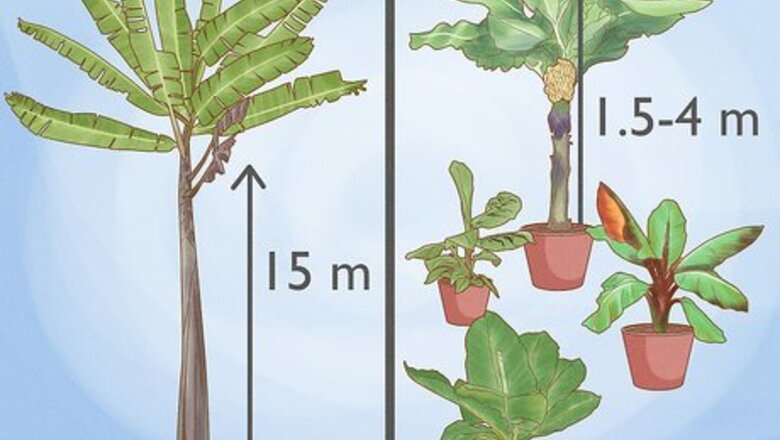
views
Getting the Right Materials
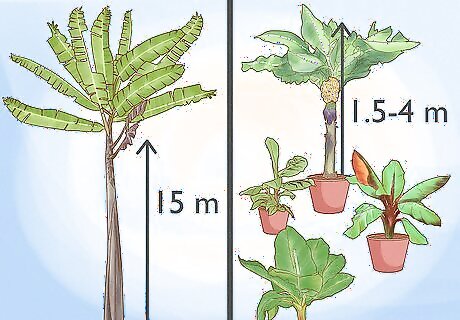
Choose a dwarf variety of banana tree. A standard banana tree can grow to be over 15 meters (49 feet) in height and will become too large for a regular pot. When purchasing a banana tree, make sure that you go for a dwarf variety of tree. These trees only grow to around 1.5 m (5 feet) to 4 m (13 feet), can be grown indoors, and will not outgrow the pot that you put them in. Look online for different varieties of dwarf banana tree corms for sale. Types of dwarf banana trees include the Dwarf Red, Dwarf Brazilian, Williams Hybrid, and Dwarf Lady Finger.
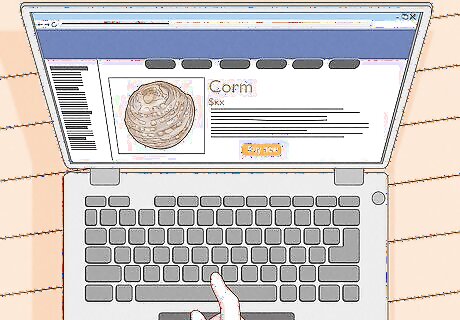
Purchase a corm or banana tree online or at the store. The corm is the base of the banana tree and contains the tree's roots. If you don't want to plant the corm and wait for the tree to grow, you can buy a young banana tree or a banana tree sucker. This will bypass having to grow new suckers from the corm, and may make it easier to plant your tree. You may also be able to buy young banana trees or banana corms at a local nursery.
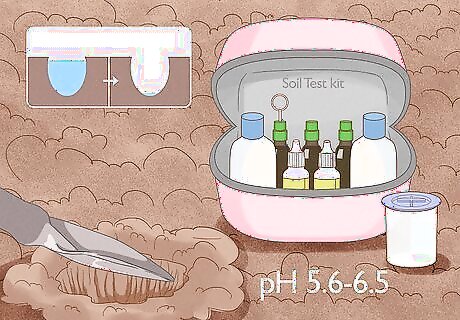
Get well-drained, mildly acidic soil for the tree. Banana trees thrive in well-drained soil. When looking for the right type of soil, consider ones with a good mix of peat, perlite, and vermiculite. A cactus or palm tree soil mixture is an excellent choice for banana trees. You can purchase bags of this soil at most home and gardening stores. Some soil is not beneficial for banana tree growth, such as standard heavy potting soil or soil that's found in your yard. Your banana tree will do best in soil with a pH of 5.6 - 6.5.
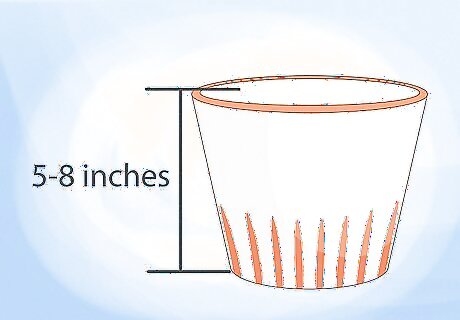
Choose a deep pot with adequate drainage. Start your tree off in a 6 inch (15 cm) or 8 inch (20 cm) pot with a drainage hole. Never plant your banana tree in a pot that doesn't have good drainage. Make sure the pot is deep so that the banana tree roots have room to expand. When choosing the material for the pot, decide on how much you want to spend and purchase a ceramic, plastic, metal, or wood pot. When your tree outgrows the first pot, you can transport it to a larger pot. Once the tree is big enough for a 30 cm (10 inch) pot, increase the size of your pot by 10-15 cm (4-6 inches) every two to three years.
Planting Your Banana Tree
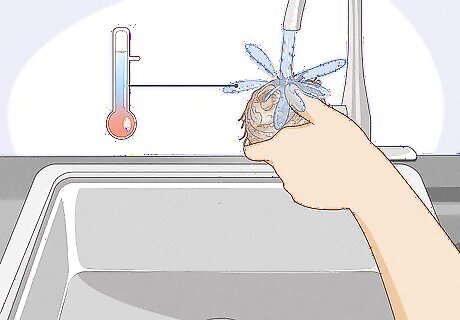
Rinse the banana corm thoroughly with lukewarm water. It's important that you rinse the banana corm before planting it to remove any pests that might be on it. Rinsing the corm will also help remove any bacterial or fungal growth.
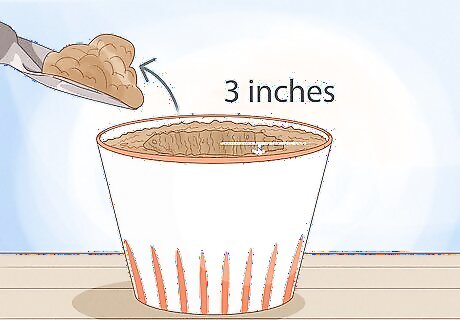
Dig a small hole for the banana corm. Fill your pot with the soil that you purchased from the gardening store. Use a spade to dig a small hole in the center of your pot about three inches (7.62 cm) deep. You may have to dig a deeper hole to accommodate the size of your corm. Make sure to leave enough space around the corm so that you can plant it deep into your pot. To test this, place your corm in the hole and make sure that the top 20% of the corm sticks out of the hole. This portion of your tree should remain exposed until new leaves start sprouting. Once the corm is planted, fill in the gaps on the side with soil.
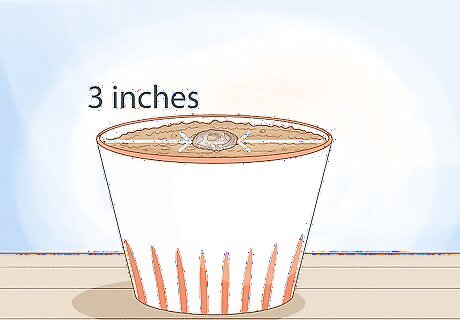
Bury the banana corm into the soil and cover the roots. Take your corm and place it in the hole that you just dug, roots side down. When planting your corm, make sure that it's 3 inches (7.5 cm) from the sides of your pot all around it so that the roots have room to grow. The top 20% of your corm should be exposed until the banana tree starts to grow leaves. When shoots or suckers start to grow from your corm, you can cover the rest of the corm with compost.
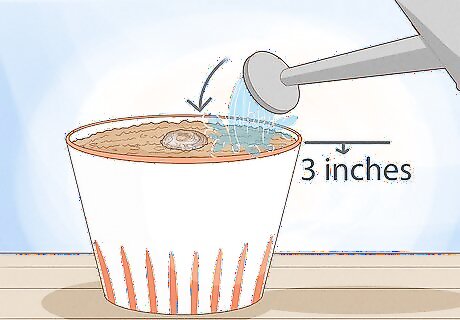
Water your tree. Water your plant thoroughly with a hose when you first plant it, saturating all of the soil surrounding the corm. Bring your tree outside and allow the water to drain through the drainage holes. After this initial watering, you can use a watering can to keep the soil moist, but not overly wet. Do not put your pot on a saucer because the pool of water can lead to bacteria and rot.
Caring for Your Banana Tree
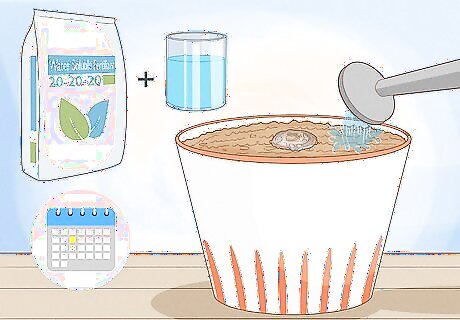
Fertilize your tree once a month. Use a fertilizer that's high in magnesium, potassium, and nitrogen to promote the growth of your tree. Combine a soluble fertilizer with water or sprinkle the top of the soil with a granular fertilizer. Regularly fertilizing the plant will provide the roots with the proper nutrients and minerals and will promote your tree's growth. During the spring and summer, you can fertilize your plant once a week. If you can't find a soluble fertilizer that is made specifically for tropical plants, consider getting a balanced 20-20-20 fertilizer. Popular fertilizer companies include Agrium, Haifa, PotashCorp, and Yara International.
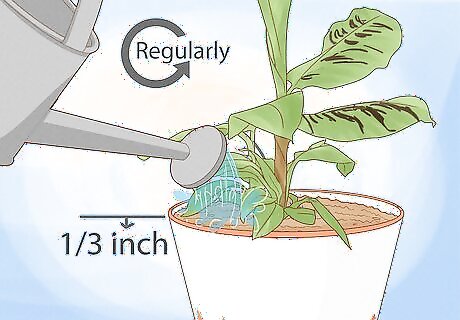
Water your tree regularly. Make sure that the soil under your tree remains moist each day. You can test this by pushing your finger down into the soil to see how dry the underlying soil is. The soil should be moist 1/2 inch (1.25 cm) down from the surface. Water your banana plant every day to keep the soil and your plant's roots hydrated. If the surface of the soil is moist and muddy, you are overwatering your banana tree.
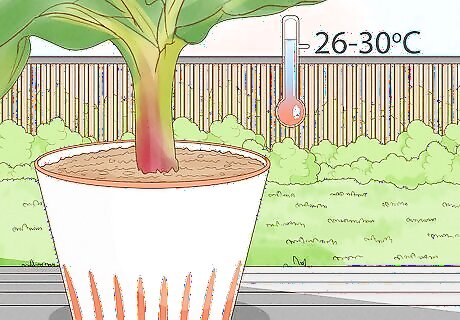
Make sure that your tree gets bright, indirect sunlight. Banana trees thrive in indirect sunlight and prefer shaded areas. If you live in a seasonal climate, you can put your banana tree outside during the summer months when it's warm. Make sure to position the tree next to surrounding foliage that can block out the direct rays of the sun. Rotate the container regularly to make sure that all sides of the plant are receiving sunlight. If your tree is indoors, put it next to a large window so that it can get adequate sunlight. The ideal temperature for banana growth is 26-30°C (78-86°F). If the temperature is below 14°C (57°F), most banana trees will stop growing.
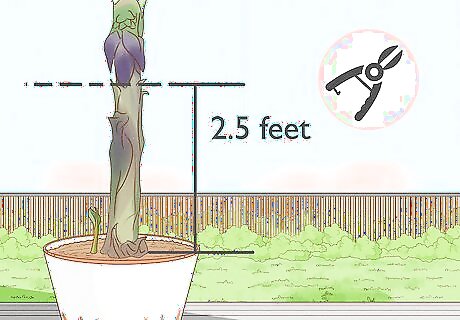
Prune your tree. After 6-8 weeks of sustained, healthy growth, your banana tree will have to be pruned. When banana trees grow, suckers will start to form on your plant. Your goal is to eliminate all but one of the suckers from your banana tree. Choose the healthiest and largest sucker from your plant and use gardening shears to cut off the rest of the suckers from the corm. When your tree starts to grow fruit it will need to be pruned again. After harvesting the fruit, cut down the tree so it's 2.5 feet (0.76 meters) from the ground, without damaging the main sucker. The tree will grow more fruit after you prune it. Suckers will look like shoots that grow out of the corm and have leaves. Replanting the additional suckers will grow a new banana tree but you must retain some of the roots from the banana corm.
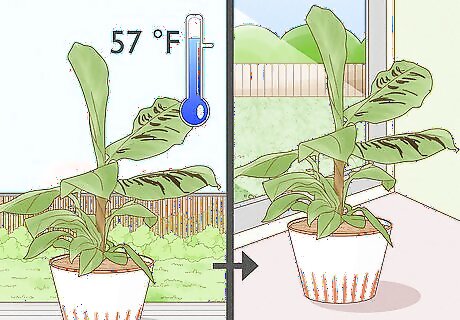
Bring your tree inside when the temperature drops below 57 °F (14 °C). Cold and heavy winds aren't healthy for your banana plant and can disrupt the growth of fruit. If you know that your yard will have cold winds, consider bringing your banana plant inside, or insulating it with rows of trees. If the seasons are changing, it's best that you bring your tree inside before it starts to get cold out. Your banana trees will start dying at 50°F (10°C).
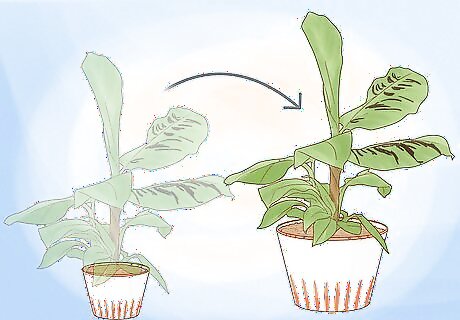
Transfer your banana tree when it outgrows its container. Transplant your tree to a larger container before it becomes root-bound. You can tell when your tree is ready for a larger container when it stops growing vertically. Lay the tree on its side and slide it out of the container. Put soil in your new pot, then place the tree in the bigger pot before filling the rest of the pot with soil. Be careful not to damage the roots when transplanting your tree. If your tree is not coming out, you may need to tap on the sides of the container.



















Comments
0 comment